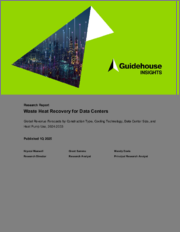
|
시장보고서
상품코드
1645200
세계의 데이터센터용 폐열 재이용 시장 : 매출 예측 - 건설 유형별, 냉각 기술별, 데이터센터 규모별, 히트펌프 사용별(2024-2033년)Waste Heat Reuse for Data Centers: Global Revenue Forecasts by Construction Type, Cooling Technology, Data Center Size, and Heat Pump Use, 2024-2033 |
||||||
데이터센터용 폐열 재사용 시장은 이제 막 시작되었지만, 이미 가정과 기업, 제조시설의 난방을 탈탄소화하고 있습니다. 국제에너지기구(IEA)에 따르면 데이터센터의 규모, 수, 전력 수요는 빠르게 증가하고 있으며, 빠르면 2026년까지 전 세계 전체 전력 소비량이 두 배로 증가할 것으로 예상됩니다. 데이터센터가 계속 성장함에 따라 재사용을 가능하게 하는 인프라가 구축되면 지속가능한 목표를 달성하기 위해 배출되지 않는 열을 대량으로 활용할 수 있게 될 것입니다. 현재 데이터센터 폐열 회수의 가장 일반적인 용도는 지역난방, 공간난방, 급탕, 농업, 양식업, 저급 공정 난방 등입니다.
오늘날 데이터센터 폐열 회수 시장의 주요 촉진요인은 새로운 데이터센터의 급속한 발전과 전 세계 기후 변화 완화 정책 증가입니다. 다른 촉진요인으로는 폐열 회수 기회에 대한 잠재적 수요자의 인식이 높아지고, 데이터센터와 수요자 모두에서 기업의 지속가능성 목표가 증가하고 있다는 점을 들 수 있습니다. 폐열회수의 확산을 가로막는 가장 큰 걸림돌은 적절한 열전달 인프라의 부족입니다. 또한 기존 시설에 폐열 회수 시스템을 개조하는 데는 상당한 비용이 소요되므로 오늘날 대부분의 폐열 회수는 새로 지어진 데이터센터에서 이루어지고 있습니다. 데이터센터와 오프테커를 결합하기 위한 정부 정책, 물류 지원, 열 운송 네트워크의 정비는 이러한 장벽을 줄이는 중요한 방법입니다.
세계의 데이터센터용 폐열 재이용 시장에 대해 조사했으며,, 현재 시장 문제, 기술 동향, 시장 성장 촉진요인, 저해요인, 정책 상황 등을 분석하였습니다. 시장 세분화에서는 2033년까지의 매출과 예측을 제시하며, 지역별, 건설 유형별, 데이터센터 냉각 기술별, 히트펌프 사용별로 구분하고 있습니다.
목차
제1장 개요
제2장 시장의 문제
- 서론
- 촉진요인
- 억제요인
제3장 산업 밸류체인
- 경쟁 구도
- M&A 및 투자 활동
- 비즈니스 모델의 진화
제4장 시장 예측
- 조사 방법
- 정의와 범위
- 세계의 예측
- 지역 예측
- 북미
- 유럽
- 기타
제5장 결론·제안
- 결론
- 3대 포인트
- 권장사항
제6장 두자어와 약어 리스트
제7장 목차
제8장 도표
제9장 조사 범위, 정보원과 조사 방법, 주석
KSA 25.02.26The market for the reuse of waste heat from data centers, while currently nascent, is already decarbonizing heating for homes, businesses, and manufacturing facilities. Data centers are rapidly growing in size, number, and electricity demand and are expected to double in power consumption globally by as soon as 2026 according to the International Energy Agency. As data centers continue to grow, a large capacity of emissions-free heat will be available to meet sustainability goals if infrastructure is in place to enable it to be reused. The most common applications of data center waste heat recovery currently include district heating, space heating, water heating, agriculture, aquaculture, and low grade process heating.
The primary driver of the data center waste heat recovery market today is the rapid development of new data centers paired with a generally increasing level of climate change abatement policies globally. Other drivers include increasing awareness of the opportunities for waste heat recovery among potential offtakers, and growing corporate sustainability goals for both data centers and offtakers. A lack of suitable heat transfer infrastructure is the single largest barrier to further adoption of waste heat recovery. Additionally, most waste heat recovery today occurs in newly built data centers, as retrofitting a heat recovery system into existing facilities involves significant costs. Government policies and logistic support for pairing data centers with offtakers, as well as the development of heat transfer networks, are key ways to reduce these barriers.
This Guidehouse Insights report examines the global market for data center waste heat recovery, analyzing current market issues, technology trends, drivers, barriers, and the policy landscape. Market forecasts are presented for revenue through 2033 and are segmented by region, construction type, data center cooling technology, and heat pump usage.
Table of Contents
1. Executive Summary
- 1.1 State of the Market
- 1.2 Market Drivers and Barriers
- 1.3 Market Forecasts
2. Market Issues
- 2.1 Introduction
- 2.1.1 Technology Definitions
- 2.1.2 Use Cases and End Users
- 2.2 Drivers
- 2.2.1 Growing Data Center Demand
- 2.2.2 Government Mandates, Policies, and Incentives
- 2.2.2.1 North America
- 2.2.2.2 Europe
- 2.2.2.3 Asia Pacific
- 2.2.3 Waste Heat End User Growth
- 2.2.4 Sustainability Goals
- 2.3 Barriers
- 2.3.1 Lack of Existing Infrastructure
- 2.3.2 Generally Low Grade of Heat
- 2.3.3 Seasonality and Offtaker Availability
- 2.3.4 Expensive Retrofit Options
3. Industry Value Chain
- 3.1 Competitive Landscape
- 3.1.1 M&A and Investment Activities
- 3.1.2 Business Model Evolution
- 3.1.2.1 Value of Heat
- 3.1.2.2 Emerging Market Approaches
4. Market Forecasts
- 4.1 Methodology
- 4.2 Definitions and Scope
- 4.3 Global Forecasts
- 4.4 Regional Forecasts
- 4.4.1 North America
- 4.4.2 Europe
- 4.4.3 Rest of World
5. Conclusions and Recommendations
- 5.1 Conclusion
- 5.2 Three Big Takeaways
- 5.3 Recommendations
- 5.3.1 Regulators and Legislators Must Offer Support, Both Monetary and Logistic
- 5.3.2 Data Center Operators Must Remain Creative While Advocating for Supportive Infrastructure
- 5.3.3 District Heating and Heat Utility Operators Should Play a Powerful Mediating Role
- 5.3.4 Manufacturers of Industrial Heat Pumps and Supporting Infrastructure Must Be Flexible and Innovative When Approaching the Data Center Market




















